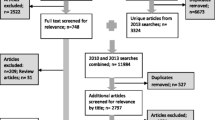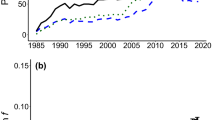Abstract
Human activities are simultaneously decreasing the size of wildlife populations (causing inbreeding) and increasing the level of stress that wildlife populations must face. Inbreeding reduces population fitness and increases extinction risk. However, very little information on the impact of stressful environments on extinction risk under inbreeding is available. We evaluated the impact of full sib inbreeding on extinction risk, using Drosophila melanogaster, in a benign and three stressful environments. The three stressful environments involved the addition to the medium of copper sulfate, methanol or alternating copper sulfate and methanol. There were 128 replicate populations for each of the four treatments. Under inbreeding, extinction rates were significantly higher in all three stressful environments compared with the benign environment. The percent extinct at generation eight (F = 0.826) for the four treatments were: 62.5% in the benign environment, 75.8%in the copper sulfate environment, 82.8% in the methanol environment, and 83.6% in the variable stress environment. However, the extinction rate in the variable stress environment did not differ significantly from the constant stress environments. Highly significant differences, among lineages, in extinction risk were detected. The results of this study indicate that wild populations are more vulnerable to inbreeding than indicated by extrapolation from captive environments.
Similar content being viewed by others
References
Bijlsma R, Bundgaard J, Boerema AC (2000) Does inbreeding affect the extinction risk of small populations?: predictions from Drosophila. J. Evol. Biol., 13, 502–514.
Byers DL, Waller DM (1999) Do plant populations purge their genetic load? Effects of population size and mating history on inbreeding depression. Annu. Rev. Ecol. Syst., 30, 479–513.
Channell R, Lomollno MV (2000) Dynamic biogeography and conservation of endangered species. Nature, 403, 84–86.
Charlesworth D, Charlesworth B (1987) Inbreeding depression and its evolutionary consequences. Annu. Rev. Ecol. Syst., 18, 237–268.
Crnokrak P, Roff DA (1999) Inbreeding depression in the wild. Heredity, 83, 260–270.
Daszak P, Cunningham AA, Hyatt AD (2000) Emerging infectious diseases of wildlife – threats to biodiversity and human health. Science, 287, 443–449.
Dobson AP, Mace GM, Poole J, Brett RA (1992) Conservation biology: The ecology and genetics of endangered species. In: Genes in Ecology (eds. Berry RJ, Crawford TJ, Hewitt GM), pp. 405–430. Blackwell, Oxford, UK.
Dudash M (1990) Relative fitness of selfed and outcrossed progeny in a self-compatible, protandrous species, Sabatia angularis: a comparison in three environments. Evolution, 44, 1129–1139.
Eldridge MDB, King JM, Loupis AK, Spencer PBS, Taylor AC, Pope LC, Hall GP (1999) Unprecedented low levels of genetic variation and inbreeding depression in an island population of the black-footed rock-wallaby. Conserv. Biol., 13, 531–541.
Falconer DS, Mackay TFC (1996) Introduction to Quantitative Genetics, Fourth ed. Longman Scientific and Technical, Burnt Mill, Harlow.
Frankham R (1995a) Inbreeding and extinction: a threshold effect. Conserv. Biol., 15, 287–289.
Frankham R (1995b) Conservation genetics. Annu. Rev. Genet., 29, 305–327.
Frankham R (1995c) Effective population size/adult population size ratios in wildlife: a review. Genet. Res., 66, 95–107.
Frankham R (1998) Inbreeding and extinction: Island populations. Conserv. Biol., 12, 665–675.
Frankham R (2000) Modeling problems in conservation genetics using laboratory animals. In: Quantitative Methods for Conservation Biology (eds. Ferson S, Burgman M), pp. 259–273. Springer-Verlag, New York, NY.
Frankham R, Ralls K (1998) Conservation biology: Inbreeding leads to extinction. Nature, 392, 441–442.
Frankham R, Yoo BH, Sheldon BL (1988) Reproductive fitness and artificial selection in animal breeding: Culling on fitness prevents a decline in reproductive fitness in lines of Drosophila melanogaster selected for increased inebriation time. Theor. Appl. Genet., 76, 909–914.
Gabriel W, Bürger R (1994) Extinction risk by mutational meltdown: synergistic effects between population regulation and genetic drift. In: Conservation Genetics (eds. Loeschcke V, Tomiuk J, Jain SK), pp. 69–84. Birkhäuser Verlag, Basel.
Hedrick PW, Kalinowski ST (2000) Inbreeding depression in conservation biology. Ann. Rev. Ecol. Syst., 31, 139–162.
Heschel MS, Paige KN (1995) Inbreeding depression, environmental stress, and population size variation in the scarlet gilia (Ipomopsis aggregata). Conserv. Biol., 9, 126–133.
Hohenboken WD, Kochera Y, Dawson PS (1991) Variability among families of Tribolium castaneum in inbreeding depression for fitness traits. J. Anim. Breed. Genet., 108, 446–454.
Hughes L (2000) Biological consequences of global warming: is the signal already apparent? Trends Ecol. Evol., 15, 56–61.
Jiminez J, Hughes K, Alaks G, Graham L, Lacy R (1994) An experimental study of inbreeding depression in a natural habitat. Science, 266, 271–273.
Kareiva PM, Kingsolver JG, Huey RB (1993) Biotic Interactions and Global Change. Sinauer, Sunderland, MA.
Lacy RC, Alaks G, Walsh A (1996) Hierarchical analysis of inbreeding depression in Peromyscus polionotus. Evolution, 50, 2187–2200.
Latter BDH, Mulley JC (1995) Genetic adaptation to captivity and inbreeding depression in small laboratory populations of Drosophila melanogaster. Genetics, 139, 255–266.
Lowe I (ed.) (1996) Australia State of the Environment Report 1996. CSIRO Publishing, Collingwood, Vic, Australia.
Lynch M, Walsh B (1998) Genetics and Analysis of Quantitative Traits. Sinauer, Sunderland, MA.
Meagher S, Penn DJ, Potts WK (2000) Male-male competition magnifies inbreeding depression in wild house mice. Proc. Natl. Acad, Sci. USA, 97, 3324–3329.
Miglior F (1994) Impact of inbreeding on dairy cattle. Ph.D. dissertation, University of Guelph, Guelph.
Miller, P (1994) Is inbreeding depression more severe in a stressful environment? Zoo Biol., 13, 195–208.
Mills LS, Smouse PE (1994) Demographic consequences of inbreeding in remnant populations. Amer. Nat., 144, 412–431.
Montgomery ME, Ballou JD, Nurthen RK, England PR, Briscoe DA, Frankham R (1997) Minimizing kinship in captive breeding programs. Zoo Biol., 16, 377–389.
Newman D, Pilson D (1997) Increased probability of extinction due to decreased genetic effective size: experimental populations of Clarkia pulchella. Evolution, 51, 354–362.
Parsons PA (1971) Extreme environment heterosis and genetic loads. Heredity, 26, 479–483.
Pollard JH (1977) Numerical and Statistical Techniques. Cambridge University Press, Cambridge, UK.
Pray LA, Goodnight CJ (1995) Genetic variation in inbreeding depression in the red flour beetle Tribolium castaneum. Evolution, 49, 176–188.
Pray LA, Schwartz JM, Goodnight CJ, Stevens L (1994) Environmental dependency of inbreeding depression: implications for conservation biology. Conserv. Biol., 8, 562–568.
Ralls K, Ballou JD (1983) Extinction: Lessons from zoos. In Genetics and conservation: A reference for managing wild animal and plant populations (eds. Schonewald-Cox CM, Chambers SM, MacBryde F, Thomas L), pp. 125–151. Benjamin/Cummings, Merlo Park, CA.
Ralls K, Meadows R (1993) Conservation genetics: Breeding like flies. Nature, 361, 689–690.
Reed DH (1998) Population size, selection, and mutation accumulation. Ph.D. dissertation, University of Houston, TX.
Reed DH, Bryant EH (2000) Experimental tests of minimum viable population size. Anim. Cons., 3, 7–14.
Reed DH, Bryant EH (2001) Fitness, genetic load and purging in experimental populations of the housefly. Conserv. Genet. 2, 57–61.
Saccheri I, Kuussaari M, Kankare M, Vikman P, Fortelius W, Hanski I (1998) Inbreeding and extinction in a butterfly metapopulation. Nature, 392, 491–494.
Schemske D (1983) Breeding system and habitat effects on fitness components in three neotropical Costus. Evolution, 37, 523–539.
Sokal RR, Rohlf FJ (1995) Biometry. W.H. Freeman and Company, New York, USA.
Wolfe L (1993) Inbreeding depression in Hydrophyllum appendiculatum: role of maternal effects, crowding, and parental mating history. Evolution, 47, 473–486.
World Conservation Monitoring Centre (1992) Global Biodiversity: Status of the Earth's Living Resources. Chapman and Hall, London.
Wright S (1977) Evolution and the Genetics of Populations, Vol. 3. Experimental Results and Evolutionary Deductions. University of Chicago Press, Chicago.
Author information
Authors and Affiliations
Corresponding author
Rights and permissions
About this article
Cite this article
Reed, D.H., Briscoe, D.A. & Frankham, R. Inbreeding and extinction: The effect of environmental stress and lineage. Conservation Genetics 3, 301–307 (2002). https://doi.org/10.1023/A:1019948130263
Issue Date:
DOI: https://doi.org/10.1023/A:1019948130263




